Apple Inc.: Comprehensive Analysis of Financial and Operational Risks
VerifiedAdded on 2022/08/29
|16
|4267
|48
Report
AI Summary
This report provides a detailed analysis of the operational and financial risks faced by Apple Inc., a global technology giant. The report begins with a company profile, highlighting its history and key products like iPhones and MacBooks. It then delves into the various risks, including operational risks such as manufacturing needs, outsourcing, and technological advancements, as well as financial risks like exchange rate fluctuations, interest rate risk, and credit risk. The report uses examples to illustrate these risks, such as rising raw material costs and currency fluctuations. Furthermore, it explores hedging strategies, including the use of futures contracts for commodities and currencies to mitigate these risks. The report concludes by summarizing the key findings and emphasizing the importance of proactive risk management for Apple Inc.'s continued success. The report provides valuable insights into the challenges and strategies involved in managing risk in a global business environment.
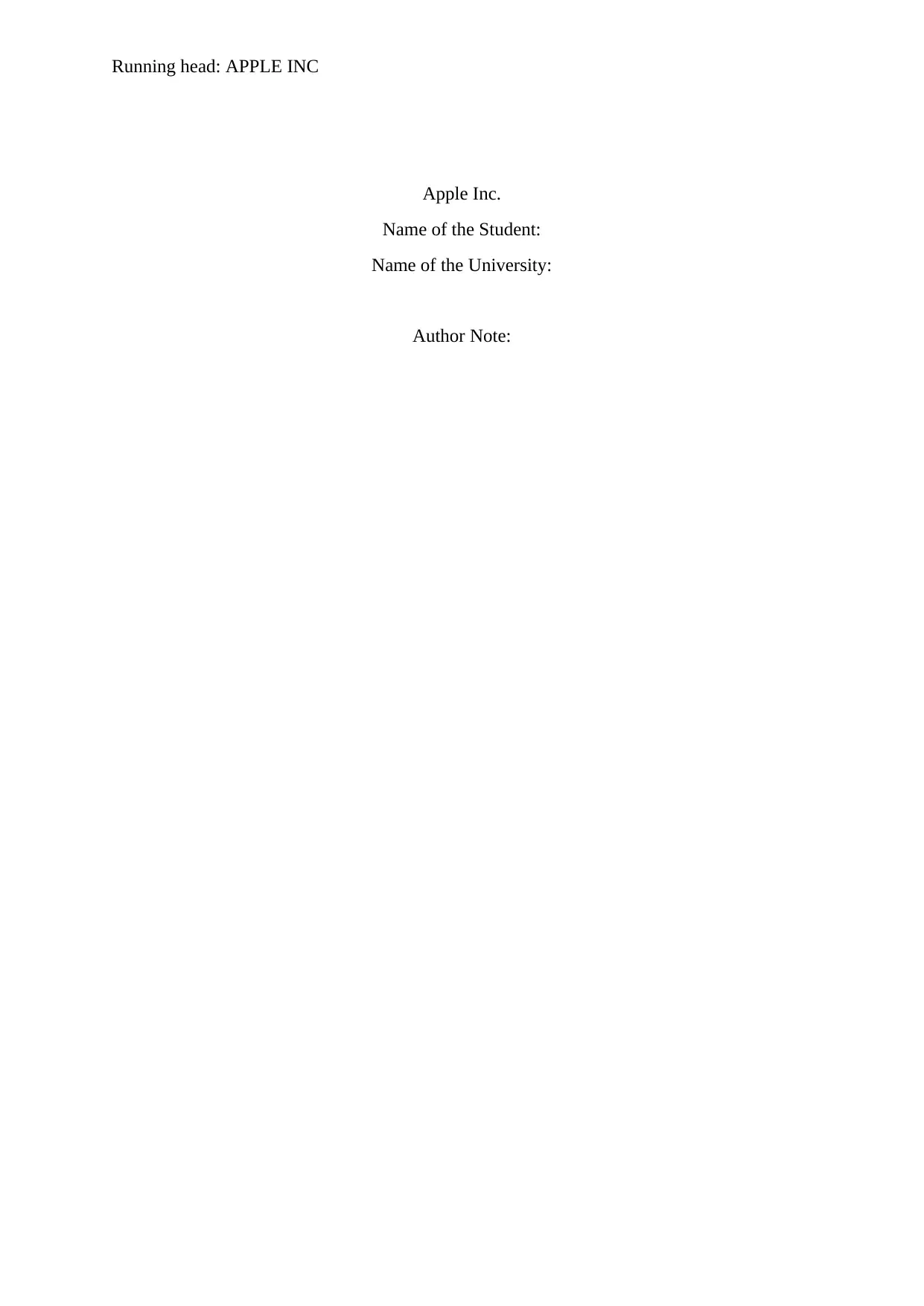
Running head: APPLE INC
Apple Inc.
Name of the Student:
Name of the University:
Author Note:
Apple Inc.
Name of the Student:
Name of the University:
Author Note:
Paraphrase This Document
Need a fresh take? Get an instant paraphrase of this document with our AI Paraphraser
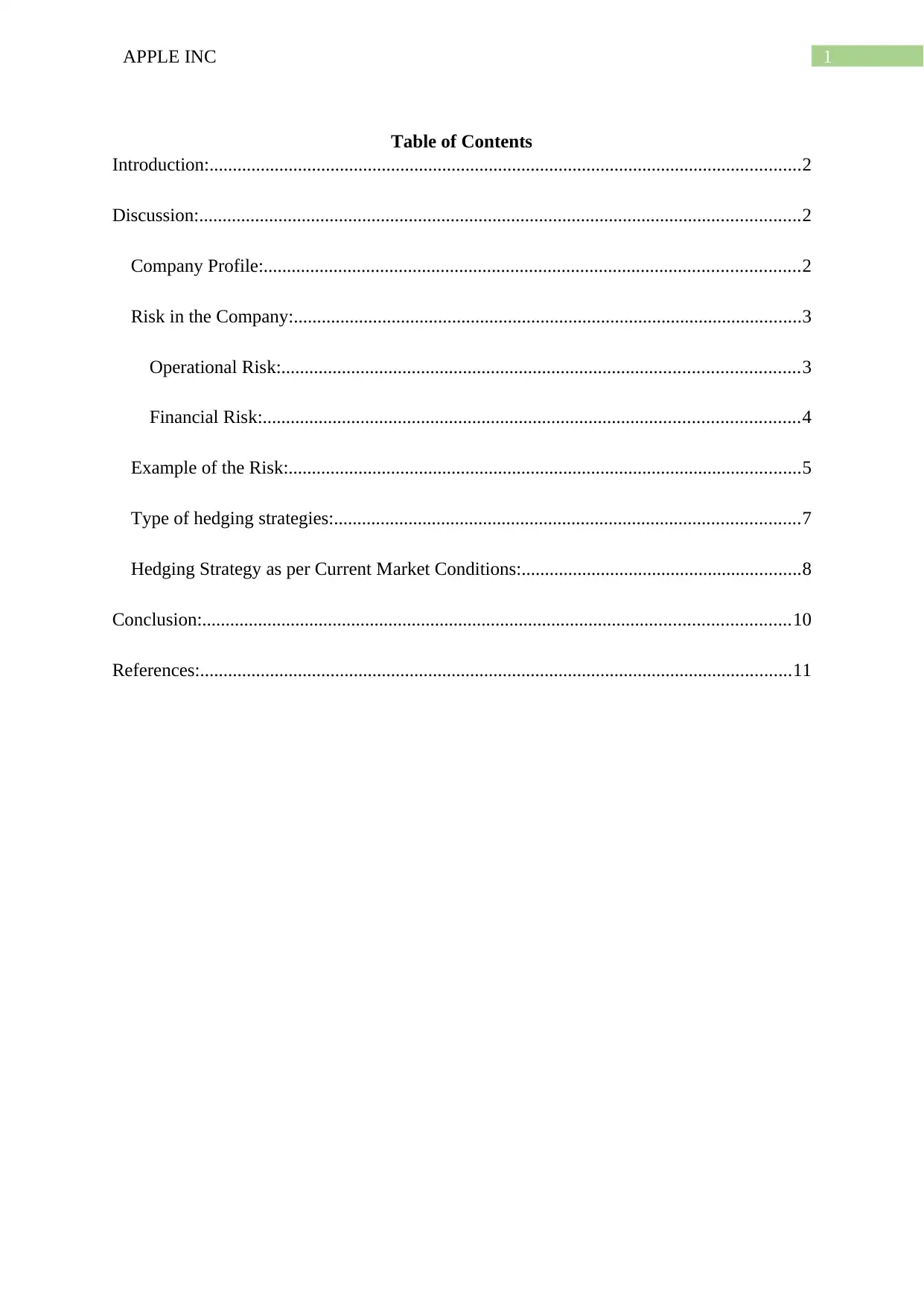
1APPLE INC
Table of Contents
Introduction:...............................................................................................................................2
Discussion:.................................................................................................................................2
Company Profile:...................................................................................................................2
Risk in the Company:.............................................................................................................3
Operational Risk:...............................................................................................................3
Financial Risk:...................................................................................................................4
Example of the Risk:..............................................................................................................5
Type of hedging strategies:....................................................................................................7
Hedging Strategy as per Current Market Conditions:............................................................8
Conclusion:..............................................................................................................................10
References:...............................................................................................................................11
Table of Contents
Introduction:...............................................................................................................................2
Discussion:.................................................................................................................................2
Company Profile:...................................................................................................................2
Risk in the Company:.............................................................................................................3
Operational Risk:...............................................................................................................3
Financial Risk:...................................................................................................................4
Example of the Risk:..............................................................................................................5
Type of hedging strategies:....................................................................................................7
Hedging Strategy as per Current Market Conditions:............................................................8
Conclusion:..............................................................................................................................10
References:...............................................................................................................................11
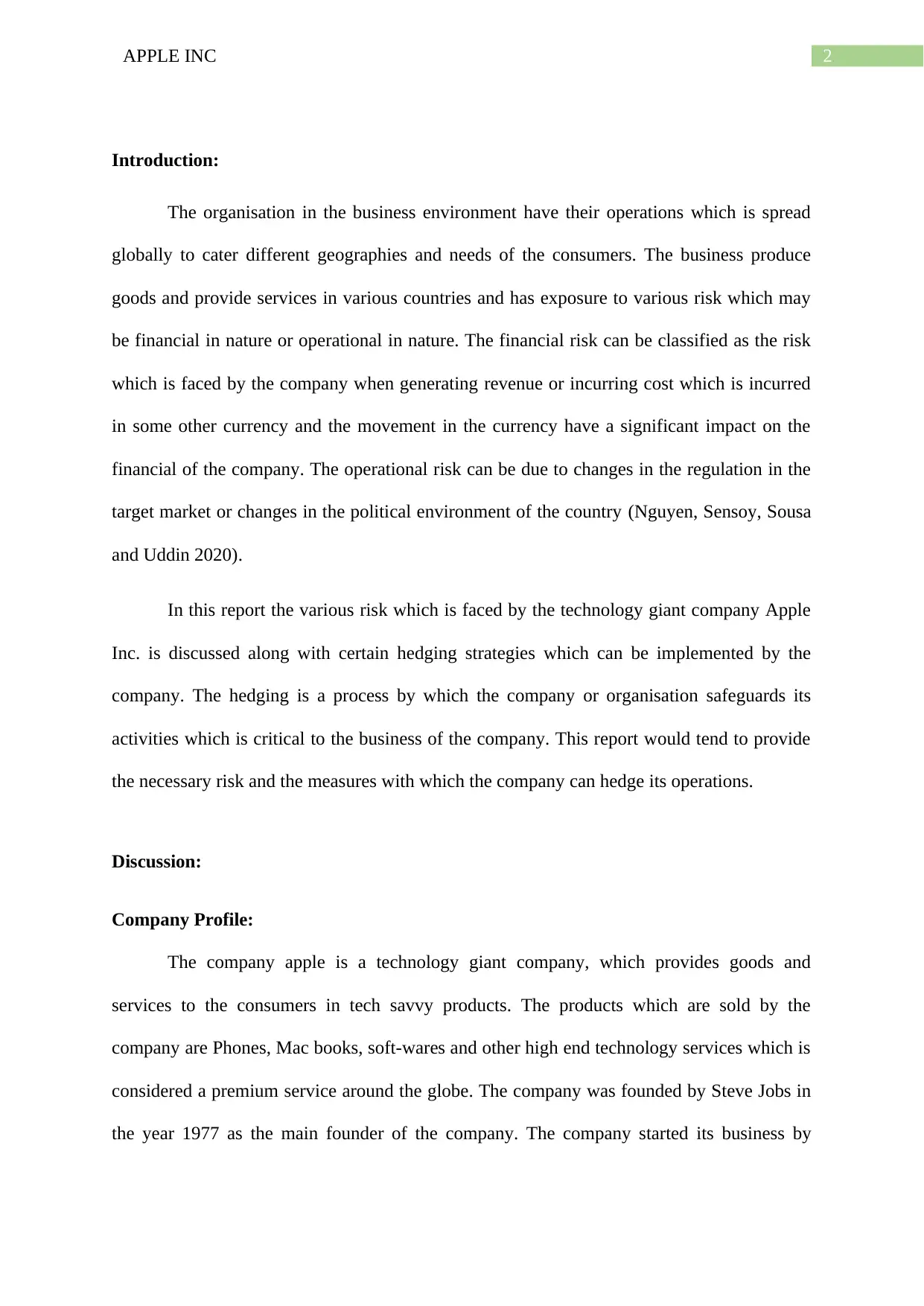
2APPLE INC
Introduction:
The organisation in the business environment have their operations which is spread
globally to cater different geographies and needs of the consumers. The business produce
goods and provide services in various countries and has exposure to various risk which may
be financial in nature or operational in nature. The financial risk can be classified as the risk
which is faced by the company when generating revenue or incurring cost which is incurred
in some other currency and the movement in the currency have a significant impact on the
financial of the company. The operational risk can be due to changes in the regulation in the
target market or changes in the political environment of the country (Nguyen, Sensoy, Sousa
and Uddin 2020).
In this report the various risk which is faced by the technology giant company Apple
Inc. is discussed along with certain hedging strategies which can be implemented by the
company. The hedging is a process by which the company or organisation safeguards its
activities which is critical to the business of the company. This report would tend to provide
the necessary risk and the measures with which the company can hedge its operations.
Discussion:
Company Profile:
The company apple is a technology giant company, which provides goods and
services to the consumers in tech savvy products. The products which are sold by the
company are Phones, Mac books, soft-wares and other high end technology services which is
considered a premium service around the globe. The company was founded by Steve Jobs in
the year 1977 as the main founder of the company. The company started its business by
Introduction:
The organisation in the business environment have their operations which is spread
globally to cater different geographies and needs of the consumers. The business produce
goods and provide services in various countries and has exposure to various risk which may
be financial in nature or operational in nature. The financial risk can be classified as the risk
which is faced by the company when generating revenue or incurring cost which is incurred
in some other currency and the movement in the currency have a significant impact on the
financial of the company. The operational risk can be due to changes in the regulation in the
target market or changes in the political environment of the country (Nguyen, Sensoy, Sousa
and Uddin 2020).
In this report the various risk which is faced by the technology giant company Apple
Inc. is discussed along with certain hedging strategies which can be implemented by the
company. The hedging is a process by which the company or organisation safeguards its
activities which is critical to the business of the company. This report would tend to provide
the necessary risk and the measures with which the company can hedge its operations.
Discussion:
Company Profile:
The company apple is a technology giant company, which provides goods and
services to the consumers in tech savvy products. The products which are sold by the
company are Phones, Mac books, soft-wares and other high end technology services which is
considered a premium service around the globe. The company was founded by Steve Jobs in
the year 1977 as the main founder of the company. The company started its business by
⊘ This is a preview!⊘
Do you want full access?
Subscribe today to unlock all pages.

Trusted by 1+ million students worldwide
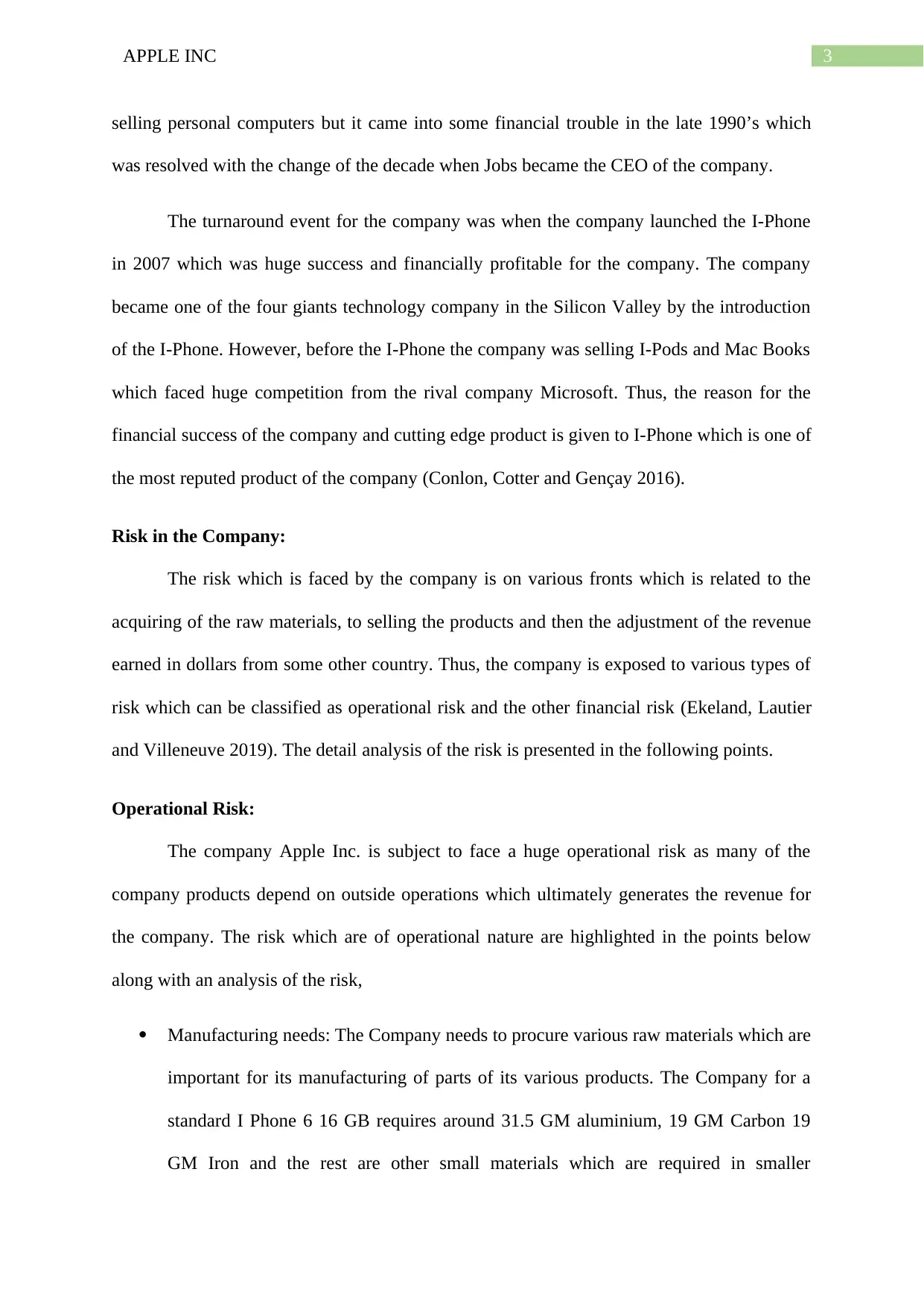
3APPLE INC
selling personal computers but it came into some financial trouble in the late 1990’s which
was resolved with the change of the decade when Jobs became the CEO of the company.
The turnaround event for the company was when the company launched the I-Phone
in 2007 which was huge success and financially profitable for the company. The company
became one of the four giants technology company in the Silicon Valley by the introduction
of the I-Phone. However, before the I-Phone the company was selling I-Pods and Mac Books
which faced huge competition from the rival company Microsoft. Thus, the reason for the
financial success of the company and cutting edge product is given to I-Phone which is one of
the most reputed product of the company (Conlon, Cotter and Gençay 2016).
Risk in the Company:
The risk which is faced by the company is on various fronts which is related to the
acquiring of the raw materials, to selling the products and then the adjustment of the revenue
earned in dollars from some other country. Thus, the company is exposed to various types of
risk which can be classified as operational risk and the other financial risk (Ekeland, Lautier
and Villeneuve 2019). The detail analysis of the risk is presented in the following points.
Operational Risk:
The company Apple Inc. is subject to face a huge operational risk as many of the
company products depend on outside operations which ultimately generates the revenue for
the company. The risk which are of operational nature are highlighted in the points below
along with an analysis of the risk,
Manufacturing needs: The Company needs to procure various raw materials which are
important for its manufacturing of parts of its various products. The Company for a
standard I Phone 6 16 GB requires around 31.5 GM aluminium, 19 GM Carbon 19
GM Iron and the rest are other small materials which are required in smaller
selling personal computers but it came into some financial trouble in the late 1990’s which
was resolved with the change of the decade when Jobs became the CEO of the company.
The turnaround event for the company was when the company launched the I-Phone
in 2007 which was huge success and financially profitable for the company. The company
became one of the four giants technology company in the Silicon Valley by the introduction
of the I-Phone. However, before the I-Phone the company was selling I-Pods and Mac Books
which faced huge competition from the rival company Microsoft. Thus, the reason for the
financial success of the company and cutting edge product is given to I-Phone which is one of
the most reputed product of the company (Conlon, Cotter and Gençay 2016).
Risk in the Company:
The risk which is faced by the company is on various fronts which is related to the
acquiring of the raw materials, to selling the products and then the adjustment of the revenue
earned in dollars from some other country. Thus, the company is exposed to various types of
risk which can be classified as operational risk and the other financial risk (Ekeland, Lautier
and Villeneuve 2019). The detail analysis of the risk is presented in the following points.
Operational Risk:
The company Apple Inc. is subject to face a huge operational risk as many of the
company products depend on outside operations which ultimately generates the revenue for
the company. The risk which are of operational nature are highlighted in the points below
along with an analysis of the risk,
Manufacturing needs: The Company needs to procure various raw materials which are
important for its manufacturing of parts of its various products. The Company for a
standard I Phone 6 16 GB requires around 31.5 GM aluminium, 19 GM Carbon 19
GM Iron and the rest are other small materials which are required in smaller
Paraphrase This Document
Need a fresh take? Get an instant paraphrase of this document with our AI Paraphraser
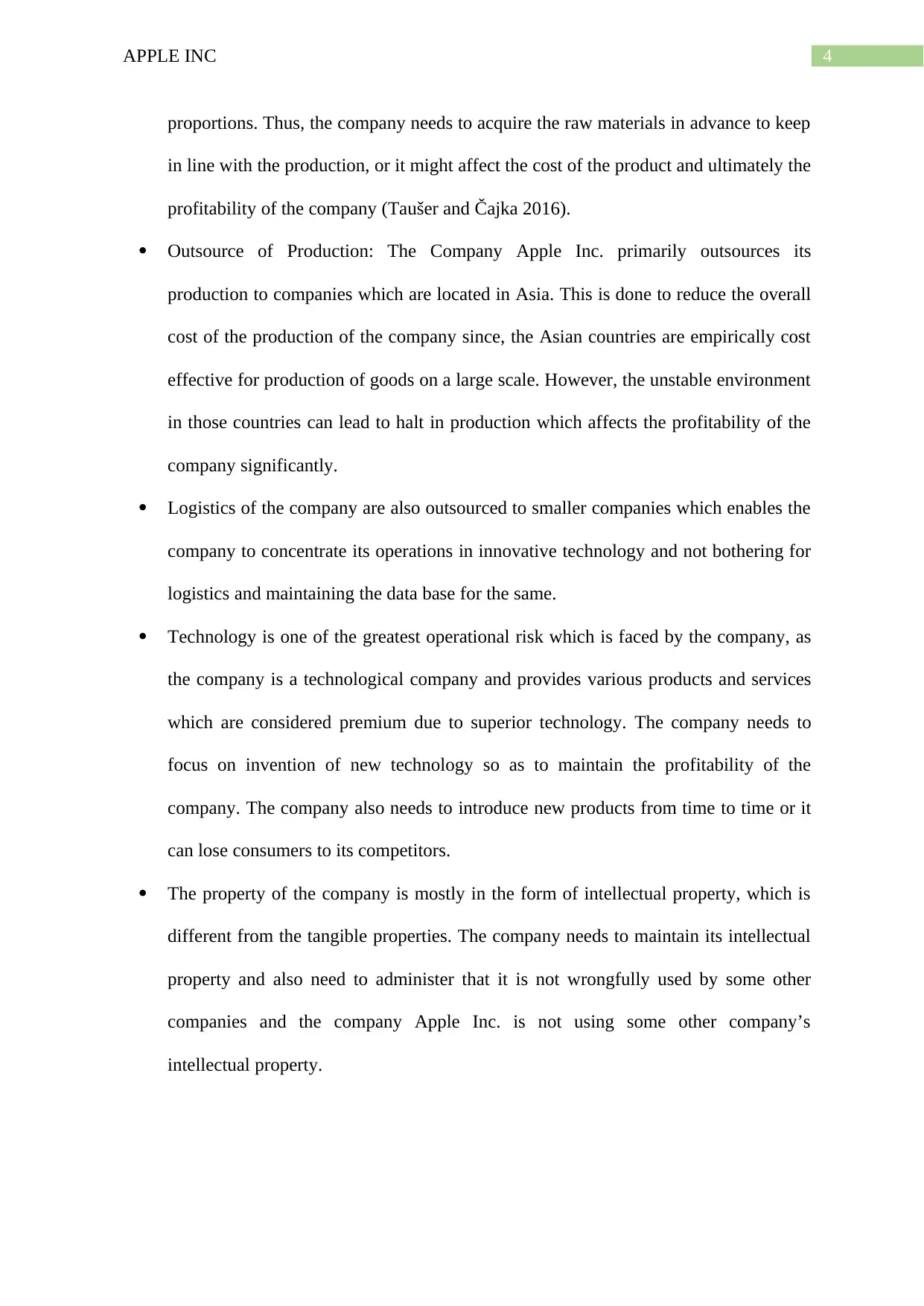
4APPLE INC
proportions. Thus, the company needs to acquire the raw materials in advance to keep
in line with the production, or it might affect the cost of the product and ultimately the
profitability of the company (Taušer and Čajka 2016).
Outsource of Production: The Company Apple Inc. primarily outsources its
production to companies which are located in Asia. This is done to reduce the overall
cost of the production of the company since, the Asian countries are empirically cost
effective for production of goods on a large scale. However, the unstable environment
in those countries can lead to halt in production which affects the profitability of the
company significantly.
Logistics of the company are also outsourced to smaller companies which enables the
company to concentrate its operations in innovative technology and not bothering for
logistics and maintaining the data base for the same.
Technology is one of the greatest operational risk which is faced by the company, as
the company is a technological company and provides various products and services
which are considered premium due to superior technology. The company needs to
focus on invention of new technology so as to maintain the profitability of the
company. The company also needs to introduce new products from time to time or it
can lose consumers to its competitors.
The property of the company is mostly in the form of intellectual property, which is
different from the tangible properties. The company needs to maintain its intellectual
property and also need to administer that it is not wrongfully used by some other
companies and the company Apple Inc. is not using some other company’s
intellectual property.
proportions. Thus, the company needs to acquire the raw materials in advance to keep
in line with the production, or it might affect the cost of the product and ultimately the
profitability of the company (Taušer and Čajka 2016).
Outsource of Production: The Company Apple Inc. primarily outsources its
production to companies which are located in Asia. This is done to reduce the overall
cost of the production of the company since, the Asian countries are empirically cost
effective for production of goods on a large scale. However, the unstable environment
in those countries can lead to halt in production which affects the profitability of the
company significantly.
Logistics of the company are also outsourced to smaller companies which enables the
company to concentrate its operations in innovative technology and not bothering for
logistics and maintaining the data base for the same.
Technology is one of the greatest operational risk which is faced by the company, as
the company is a technological company and provides various products and services
which are considered premium due to superior technology. The company needs to
focus on invention of new technology so as to maintain the profitability of the
company. The company also needs to introduce new products from time to time or it
can lose consumers to its competitors.
The property of the company is mostly in the form of intellectual property, which is
different from the tangible properties. The company needs to maintain its intellectual
property and also need to administer that it is not wrongfully used by some other
companies and the company Apple Inc. is not using some other company’s
intellectual property.
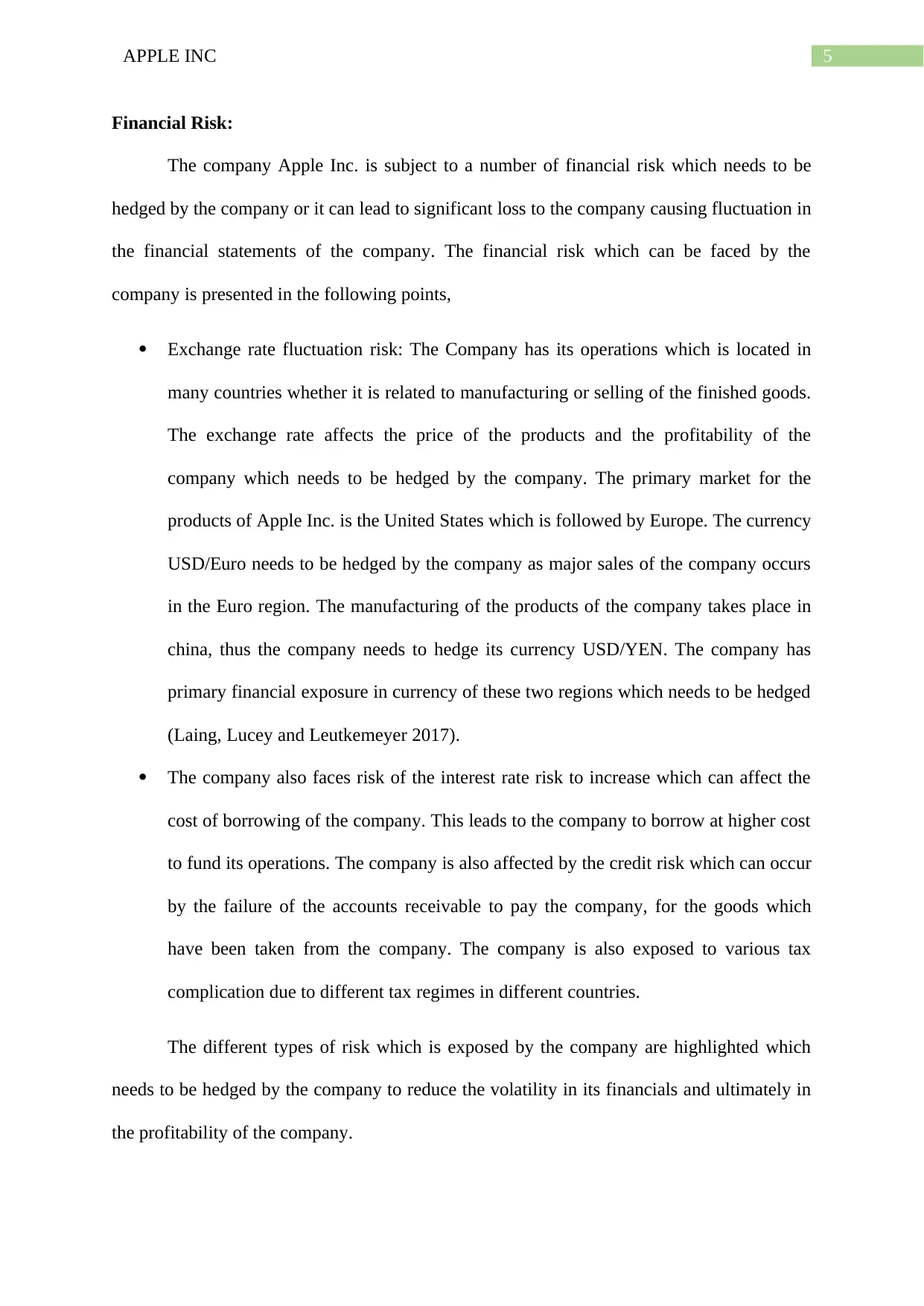
5APPLE INC
Financial Risk:
The company Apple Inc. is subject to a number of financial risk which needs to be
hedged by the company or it can lead to significant loss to the company causing fluctuation in
the financial statements of the company. The financial risk which can be faced by the
company is presented in the following points,
Exchange rate fluctuation risk: The Company has its operations which is located in
many countries whether it is related to manufacturing or selling of the finished goods.
The exchange rate affects the price of the products and the profitability of the
company which needs to be hedged by the company. The primary market for the
products of Apple Inc. is the United States which is followed by Europe. The currency
USD/Euro needs to be hedged by the company as major sales of the company occurs
in the Euro region. The manufacturing of the products of the company takes place in
china, thus the company needs to hedge its currency USD/YEN. The company has
primary financial exposure in currency of these two regions which needs to be hedged
(Laing, Lucey and Leutkemeyer 2017).
The company also faces risk of the interest rate risk to increase which can affect the
cost of borrowing of the company. This leads to the company to borrow at higher cost
to fund its operations. The company is also affected by the credit risk which can occur
by the failure of the accounts receivable to pay the company, for the goods which
have been taken from the company. The company is also exposed to various tax
complication due to different tax regimes in different countries.
The different types of risk which is exposed by the company are highlighted which
needs to be hedged by the company to reduce the volatility in its financials and ultimately in
the profitability of the company.
Financial Risk:
The company Apple Inc. is subject to a number of financial risk which needs to be
hedged by the company or it can lead to significant loss to the company causing fluctuation in
the financial statements of the company. The financial risk which can be faced by the
company is presented in the following points,
Exchange rate fluctuation risk: The Company has its operations which is located in
many countries whether it is related to manufacturing or selling of the finished goods.
The exchange rate affects the price of the products and the profitability of the
company which needs to be hedged by the company. The primary market for the
products of Apple Inc. is the United States which is followed by Europe. The currency
USD/Euro needs to be hedged by the company as major sales of the company occurs
in the Euro region. The manufacturing of the products of the company takes place in
china, thus the company needs to hedge its currency USD/YEN. The company has
primary financial exposure in currency of these two regions which needs to be hedged
(Laing, Lucey and Leutkemeyer 2017).
The company also faces risk of the interest rate risk to increase which can affect the
cost of borrowing of the company. This leads to the company to borrow at higher cost
to fund its operations. The company is also affected by the credit risk which can occur
by the failure of the accounts receivable to pay the company, for the goods which
have been taken from the company. The company is also exposed to various tax
complication due to different tax regimes in different countries.
The different types of risk which is exposed by the company are highlighted which
needs to be hedged by the company to reduce the volatility in its financials and ultimately in
the profitability of the company.
⊘ This is a preview!⊘
Do you want full access?
Subscribe today to unlock all pages.

Trusted by 1+ million students worldwide
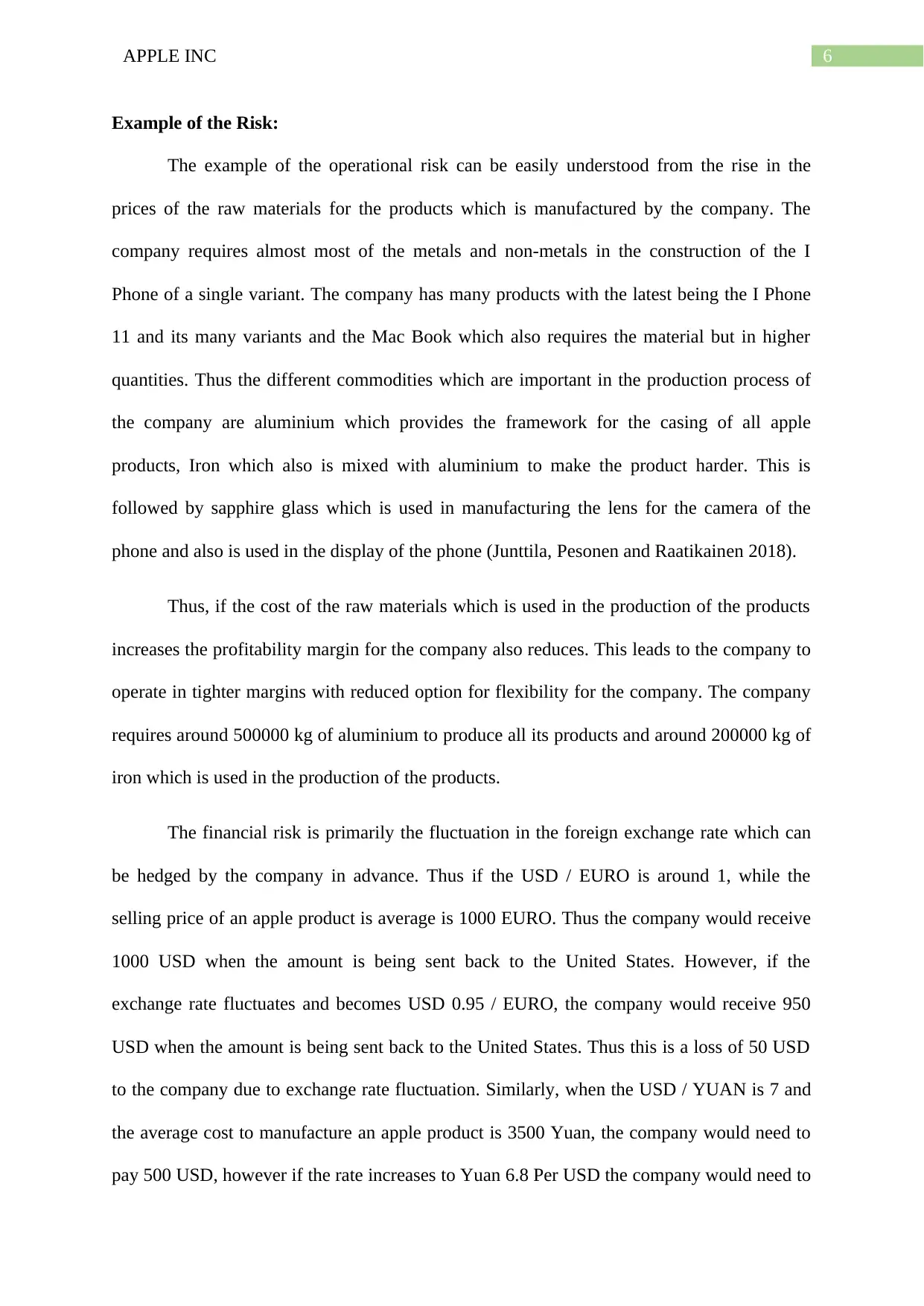
6APPLE INC
Example of the Risk:
The example of the operational risk can be easily understood from the rise in the
prices of the raw materials for the products which is manufactured by the company. The
company requires almost most of the metals and non-metals in the construction of the I
Phone of a single variant. The company has many products with the latest being the I Phone
11 and its many variants and the Mac Book which also requires the material but in higher
quantities. Thus the different commodities which are important in the production process of
the company are aluminium which provides the framework for the casing of all apple
products, Iron which also is mixed with aluminium to make the product harder. This is
followed by sapphire glass which is used in manufacturing the lens for the camera of the
phone and also is used in the display of the phone (Junttila, Pesonen and Raatikainen 2018).
Thus, if the cost of the raw materials which is used in the production of the products
increases the profitability margin for the company also reduces. This leads to the company to
operate in tighter margins with reduced option for flexibility for the company. The company
requires around 500000 kg of aluminium to produce all its products and around 200000 kg of
iron which is used in the production of the products.
The financial risk is primarily the fluctuation in the foreign exchange rate which can
be hedged by the company in advance. Thus if the USD / EURO is around 1, while the
selling price of an apple product is average is 1000 EURO. Thus the company would receive
1000 USD when the amount is being sent back to the United States. However, if the
exchange rate fluctuates and becomes USD 0.95 / EURO, the company would receive 950
USD when the amount is being sent back to the United States. Thus this is a loss of 50 USD
to the company due to exchange rate fluctuation. Similarly, when the USD / YUAN is 7 and
the average cost to manufacture an apple product is 3500 Yuan, the company would need to
pay 500 USD, however if the rate increases to Yuan 6.8 Per USD the company would need to
Example of the Risk:
The example of the operational risk can be easily understood from the rise in the
prices of the raw materials for the products which is manufactured by the company. The
company requires almost most of the metals and non-metals in the construction of the I
Phone of a single variant. The company has many products with the latest being the I Phone
11 and its many variants and the Mac Book which also requires the material but in higher
quantities. Thus the different commodities which are important in the production process of
the company are aluminium which provides the framework for the casing of all apple
products, Iron which also is mixed with aluminium to make the product harder. This is
followed by sapphire glass which is used in manufacturing the lens for the camera of the
phone and also is used in the display of the phone (Junttila, Pesonen and Raatikainen 2018).
Thus, if the cost of the raw materials which is used in the production of the products
increases the profitability margin for the company also reduces. This leads to the company to
operate in tighter margins with reduced option for flexibility for the company. The company
requires around 500000 kg of aluminium to produce all its products and around 200000 kg of
iron which is used in the production of the products.
The financial risk is primarily the fluctuation in the foreign exchange rate which can
be hedged by the company in advance. Thus if the USD / EURO is around 1, while the
selling price of an apple product is average is 1000 EURO. Thus the company would receive
1000 USD when the amount is being sent back to the United States. However, if the
exchange rate fluctuates and becomes USD 0.95 / EURO, the company would receive 950
USD when the amount is being sent back to the United States. Thus this is a loss of 50 USD
to the company due to exchange rate fluctuation. Similarly, when the USD / YUAN is 7 and
the average cost to manufacture an apple product is 3500 Yuan, the company would need to
pay 500 USD, however if the rate increases to Yuan 6.8 Per USD the company would need to
Paraphrase This Document
Need a fresh take? Get an instant paraphrase of this document with our AI Paraphraser
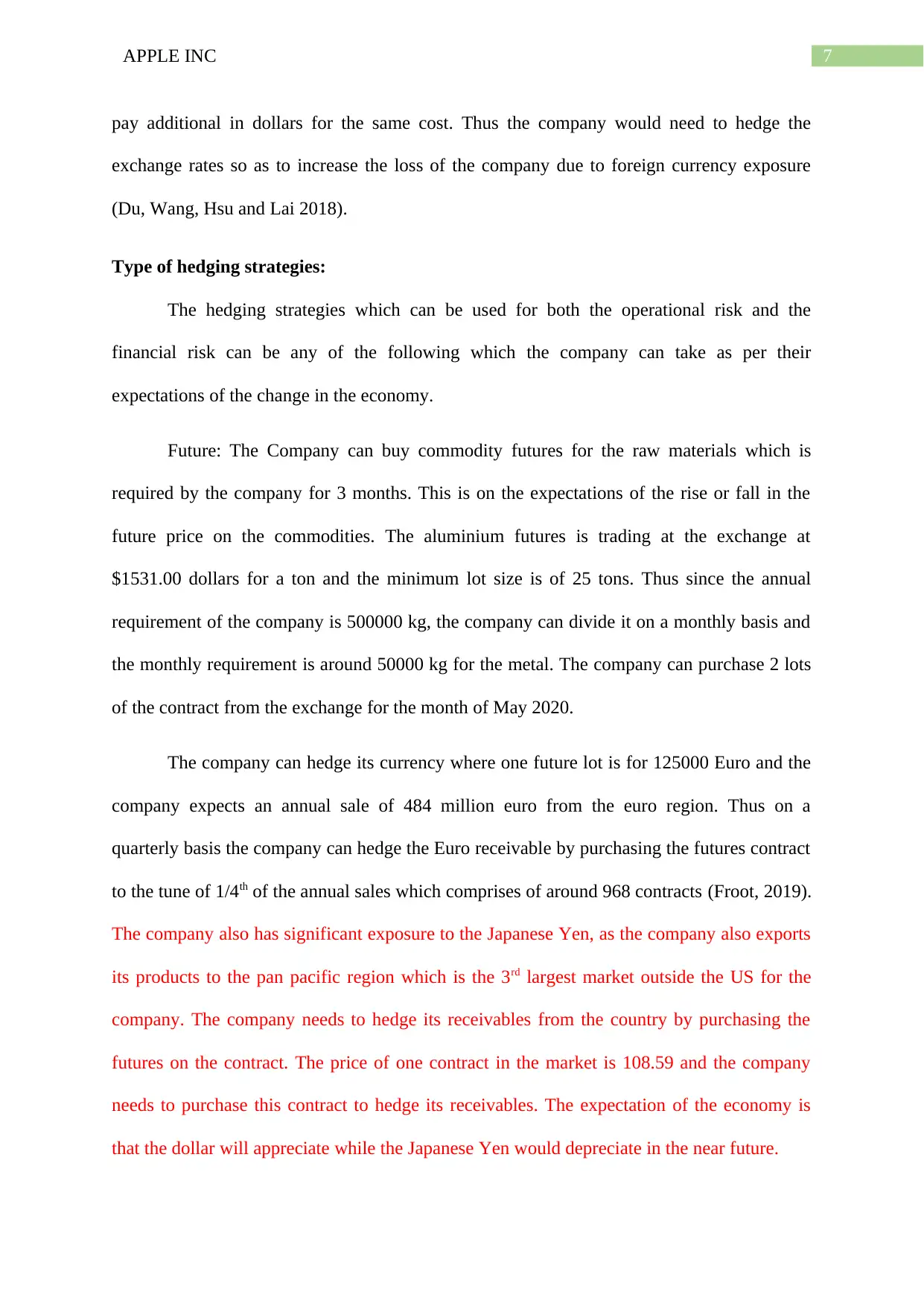
7APPLE INC
pay additional in dollars for the same cost. Thus the company would need to hedge the
exchange rates so as to increase the loss of the company due to foreign currency exposure
(Du, Wang, Hsu and Lai 2018).
Type of hedging strategies:
The hedging strategies which can be used for both the operational risk and the
financial risk can be any of the following which the company can take as per their
expectations of the change in the economy.
Future: The Company can buy commodity futures for the raw materials which is
required by the company for 3 months. This is on the expectations of the rise or fall in the
future price on the commodities. The aluminium futures is trading at the exchange at
$1531.00 dollars for a ton and the minimum lot size is of 25 tons. Thus since the annual
requirement of the company is 500000 kg, the company can divide it on a monthly basis and
the monthly requirement is around 50000 kg for the metal. The company can purchase 2 lots
of the contract from the exchange for the month of May 2020.
The company can hedge its currency where one future lot is for 125000 Euro and the
company expects an annual sale of 484 million euro from the euro region. Thus on a
quarterly basis the company can hedge the Euro receivable by purchasing the futures contract
to the tune of 1/4th of the annual sales which comprises of around 968 contracts (Froot, 2019).
The company also has significant exposure to the Japanese Yen, as the company also exports
its products to the pan pacific region which is the 3rd largest market outside the US for the
company. The company needs to hedge its receivables from the country by purchasing the
futures on the contract. The price of one contract in the market is 108.59 and the company
needs to purchase this contract to hedge its receivables. The expectation of the economy is
that the dollar will appreciate while the Japanese Yen would depreciate in the near future.
pay additional in dollars for the same cost. Thus the company would need to hedge the
exchange rates so as to increase the loss of the company due to foreign currency exposure
(Du, Wang, Hsu and Lai 2018).
Type of hedging strategies:
The hedging strategies which can be used for both the operational risk and the
financial risk can be any of the following which the company can take as per their
expectations of the change in the economy.
Future: The Company can buy commodity futures for the raw materials which is
required by the company for 3 months. This is on the expectations of the rise or fall in the
future price on the commodities. The aluminium futures is trading at the exchange at
$1531.00 dollars for a ton and the minimum lot size is of 25 tons. Thus since the annual
requirement of the company is 500000 kg, the company can divide it on a monthly basis and
the monthly requirement is around 50000 kg for the metal. The company can purchase 2 lots
of the contract from the exchange for the month of May 2020.
The company can hedge its currency where one future lot is for 125000 Euro and the
company expects an annual sale of 484 million euro from the euro region. Thus on a
quarterly basis the company can hedge the Euro receivable by purchasing the futures contract
to the tune of 1/4th of the annual sales which comprises of around 968 contracts (Froot, 2019).
The company also has significant exposure to the Japanese Yen, as the company also exports
its products to the pan pacific region which is the 3rd largest market outside the US for the
company. The company needs to hedge its receivables from the country by purchasing the
futures on the contract. The price of one contract in the market is 108.59 and the company
needs to purchase this contract to hedge its receivables. The expectation of the economy is
that the dollar will appreciate while the Japanese Yen would depreciate in the near future.
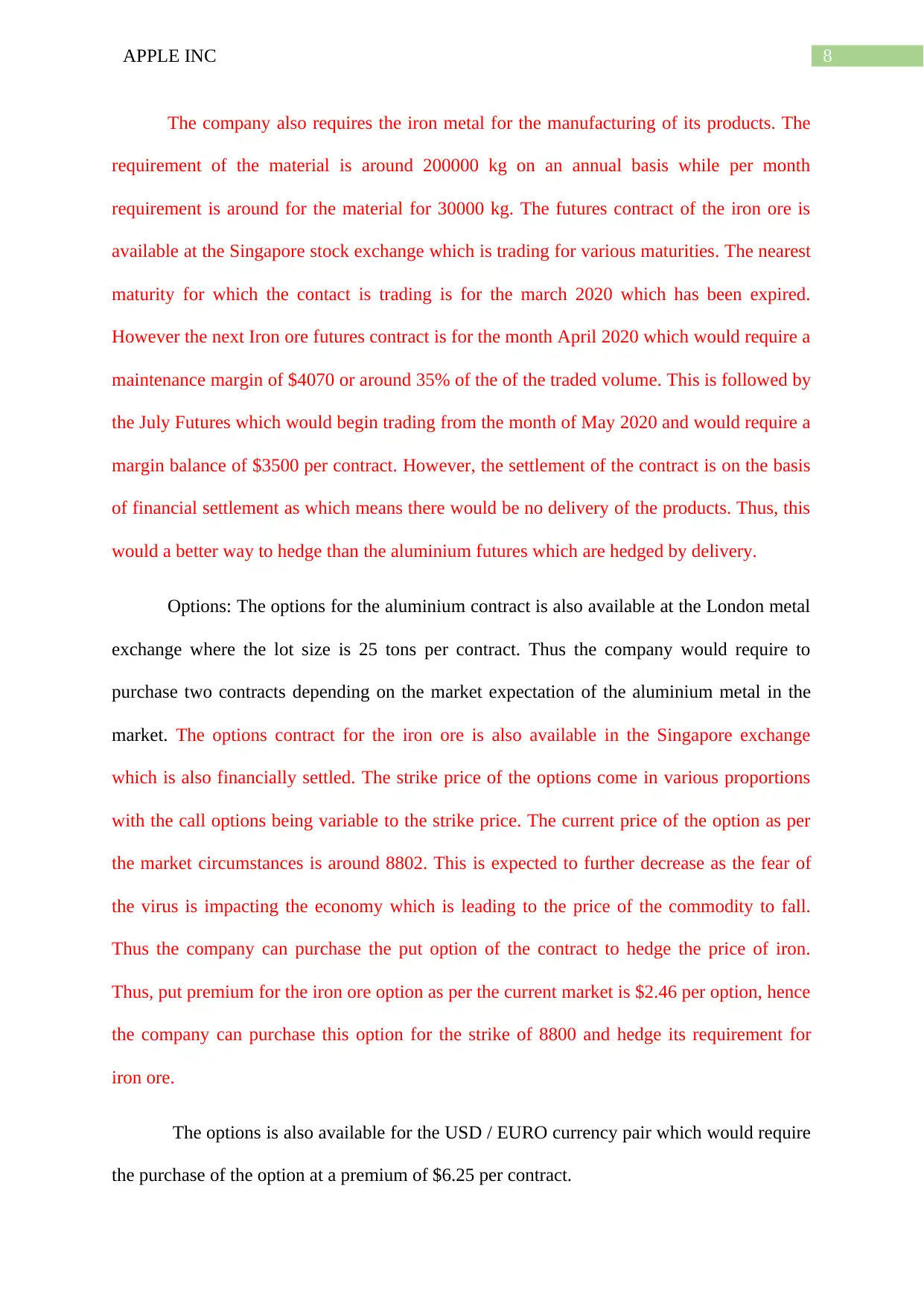
8APPLE INC
The company also requires the iron metal for the manufacturing of its products. The
requirement of the material is around 200000 kg on an annual basis while per month
requirement is around for the material for 30000 kg. The futures contract of the iron ore is
available at the Singapore stock exchange which is trading for various maturities. The nearest
maturity for which the contact is trading is for the march 2020 which has been expired.
However the next Iron ore futures contract is for the month April 2020 which would require a
maintenance margin of $4070 or around 35% of the of the traded volume. This is followed by
the July Futures which would begin trading from the month of May 2020 and would require a
margin balance of $3500 per contract. However, the settlement of the contract is on the basis
of financial settlement as which means there would be no delivery of the products. Thus, this
would a better way to hedge than the aluminium futures which are hedged by delivery.
Options: The options for the aluminium contract is also available at the London metal
exchange where the lot size is 25 tons per contract. Thus the company would require to
purchase two contracts depending on the market expectation of the aluminium metal in the
market. The options contract for the iron ore is also available in the Singapore exchange
which is also financially settled. The strike price of the options come in various proportions
with the call options being variable to the strike price. The current price of the option as per
the market circumstances is around 8802. This is expected to further decrease as the fear of
the virus is impacting the economy which is leading to the price of the commodity to fall.
Thus the company can purchase the put option of the contract to hedge the price of iron.
Thus, put premium for the iron ore option as per the current market is $2.46 per option, hence
the company can purchase this option for the strike of 8800 and hedge its requirement for
iron ore.
The options is also available for the USD / EURO currency pair which would require
the purchase of the option at a premium of $6.25 per contract.
The company also requires the iron metal for the manufacturing of its products. The
requirement of the material is around 200000 kg on an annual basis while per month
requirement is around for the material for 30000 kg. The futures contract of the iron ore is
available at the Singapore stock exchange which is trading for various maturities. The nearest
maturity for which the contact is trading is for the march 2020 which has been expired.
However the next Iron ore futures contract is for the month April 2020 which would require a
maintenance margin of $4070 or around 35% of the of the traded volume. This is followed by
the July Futures which would begin trading from the month of May 2020 and would require a
margin balance of $3500 per contract. However, the settlement of the contract is on the basis
of financial settlement as which means there would be no delivery of the products. Thus, this
would a better way to hedge than the aluminium futures which are hedged by delivery.
Options: The options for the aluminium contract is also available at the London metal
exchange where the lot size is 25 tons per contract. Thus the company would require to
purchase two contracts depending on the market expectation of the aluminium metal in the
market. The options contract for the iron ore is also available in the Singapore exchange
which is also financially settled. The strike price of the options come in various proportions
with the call options being variable to the strike price. The current price of the option as per
the market circumstances is around 8802. This is expected to further decrease as the fear of
the virus is impacting the economy which is leading to the price of the commodity to fall.
Thus the company can purchase the put option of the contract to hedge the price of iron.
Thus, put premium for the iron ore option as per the current market is $2.46 per option, hence
the company can purchase this option for the strike of 8800 and hedge its requirement for
iron ore.
The options is also available for the USD / EURO currency pair which would require
the purchase of the option at a premium of $6.25 per contract.
⊘ This is a preview!⊘
Do you want full access?
Subscribe today to unlock all pages.

Trusted by 1+ million students worldwide
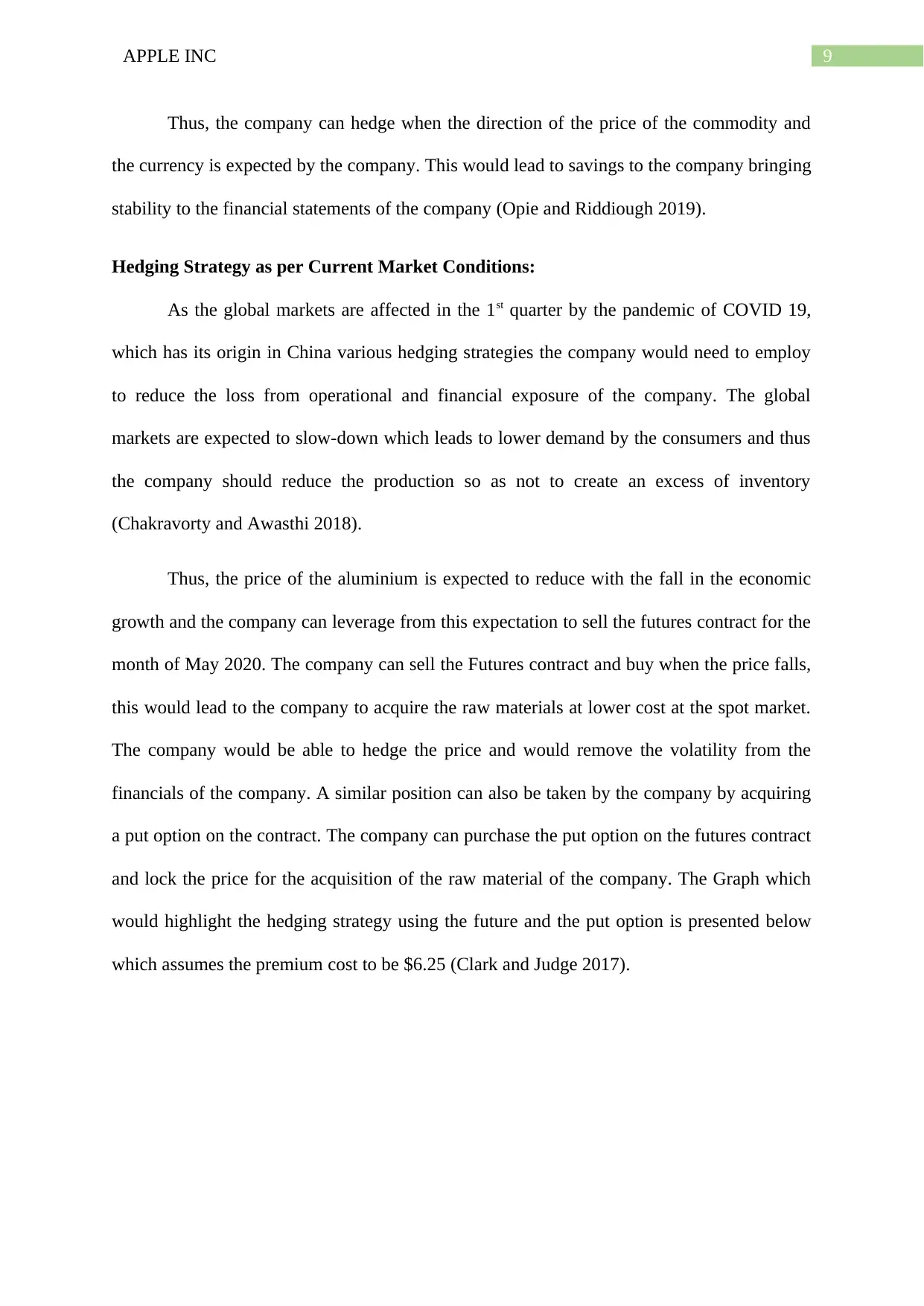
9APPLE INC
Thus, the company can hedge when the direction of the price of the commodity and
the currency is expected by the company. This would lead to savings to the company bringing
stability to the financial statements of the company (Opie and Riddiough 2019).
Hedging Strategy as per Current Market Conditions:
As the global markets are affected in the 1st quarter by the pandemic of COVID 19,
which has its origin in China various hedging strategies the company would need to employ
to reduce the loss from operational and financial exposure of the company. The global
markets are expected to slow-down which leads to lower demand by the consumers and thus
the company should reduce the production so as not to create an excess of inventory
(Chakravorty and Awasthi 2018).
Thus, the price of the aluminium is expected to reduce with the fall in the economic
growth and the company can leverage from this expectation to sell the futures contract for the
month of May 2020. The company can sell the Futures contract and buy when the price falls,
this would lead to the company to acquire the raw materials at lower cost at the spot market.
The company would be able to hedge the price and would remove the volatility from the
financials of the company. A similar position can also be taken by the company by acquiring
a put option on the contract. The company can purchase the put option on the futures contract
and lock the price for the acquisition of the raw material of the company. The Graph which
would highlight the hedging strategy using the future and the put option is presented below
which assumes the premium cost to be $6.25 (Clark and Judge 2017).
Thus, the company can hedge when the direction of the price of the commodity and
the currency is expected by the company. This would lead to savings to the company bringing
stability to the financial statements of the company (Opie and Riddiough 2019).
Hedging Strategy as per Current Market Conditions:
As the global markets are affected in the 1st quarter by the pandemic of COVID 19,
which has its origin in China various hedging strategies the company would need to employ
to reduce the loss from operational and financial exposure of the company. The global
markets are expected to slow-down which leads to lower demand by the consumers and thus
the company should reduce the production so as not to create an excess of inventory
(Chakravorty and Awasthi 2018).
Thus, the price of the aluminium is expected to reduce with the fall in the economic
growth and the company can leverage from this expectation to sell the futures contract for the
month of May 2020. The company can sell the Futures contract and buy when the price falls,
this would lead to the company to acquire the raw materials at lower cost at the spot market.
The company would be able to hedge the price and would remove the volatility from the
financials of the company. A similar position can also be taken by the company by acquiring
a put option on the contract. The company can purchase the put option on the futures contract
and lock the price for the acquisition of the raw material of the company. The Graph which
would highlight the hedging strategy using the future and the put option is presented below
which assumes the premium cost to be $6.25 (Clark and Judge 2017).
Paraphrase This Document
Need a fresh take? Get an instant paraphrase of this document with our AI Paraphraser
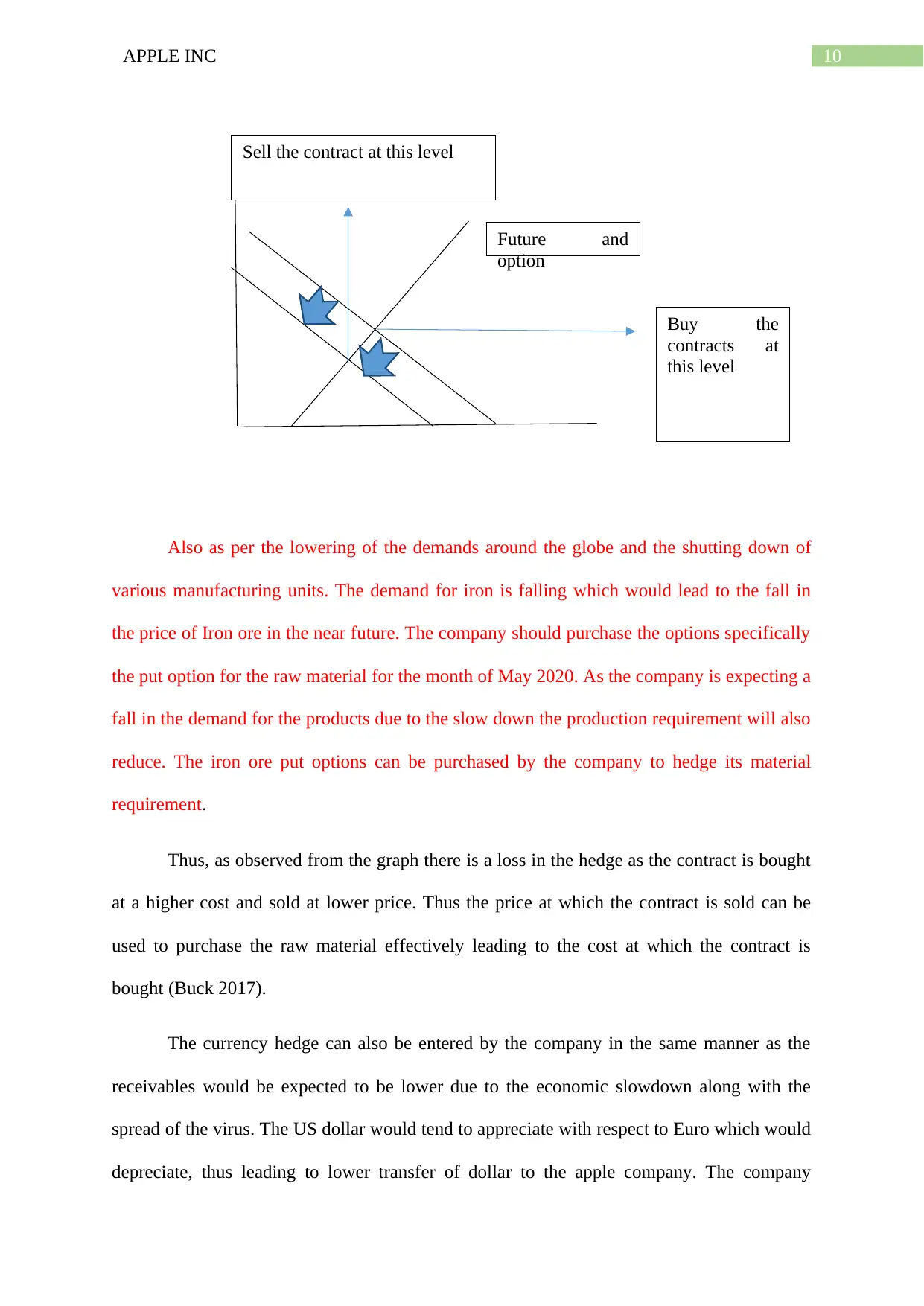
10APPLE INC
Future and
option
Buy the
contracts at
this level
Sell the contract at this level
Also as per the lowering of the demands around the globe and the shutting down of
various manufacturing units. The demand for iron is falling which would lead to the fall in
the price of Iron ore in the near future. The company should purchase the options specifically
the put option for the raw material for the month of May 2020. As the company is expecting a
fall in the demand for the products due to the slow down the production requirement will also
reduce. The iron ore put options can be purchased by the company to hedge its material
requirement.
Thus, as observed from the graph there is a loss in the hedge as the contract is bought
at a higher cost and sold at lower price. Thus the price at which the contract is sold can be
used to purchase the raw material effectively leading to the cost at which the contract is
bought (Buck 2017).
The currency hedge can also be entered by the company in the same manner as the
receivables would be expected to be lower due to the economic slowdown along with the
spread of the virus. The US dollar would tend to appreciate with respect to Euro which would
depreciate, thus leading to lower transfer of dollar to the apple company. The company
Future and
option
Buy the
contracts at
this level
Sell the contract at this level
Also as per the lowering of the demands around the globe and the shutting down of
various manufacturing units. The demand for iron is falling which would lead to the fall in
the price of Iron ore in the near future. The company should purchase the options specifically
the put option for the raw material for the month of May 2020. As the company is expecting a
fall in the demand for the products due to the slow down the production requirement will also
reduce. The iron ore put options can be purchased by the company to hedge its material
requirement.
Thus, as observed from the graph there is a loss in the hedge as the contract is bought
at a higher cost and sold at lower price. Thus the price at which the contract is sold can be
used to purchase the raw material effectively leading to the cost at which the contract is
bought (Buck 2017).
The currency hedge can also be entered by the company in the same manner as the
receivables would be expected to be lower due to the economic slowdown along with the
spread of the virus. The US dollar would tend to appreciate with respect to Euro which would
depreciate, thus leading to lower transfer of dollar to the apple company. The company
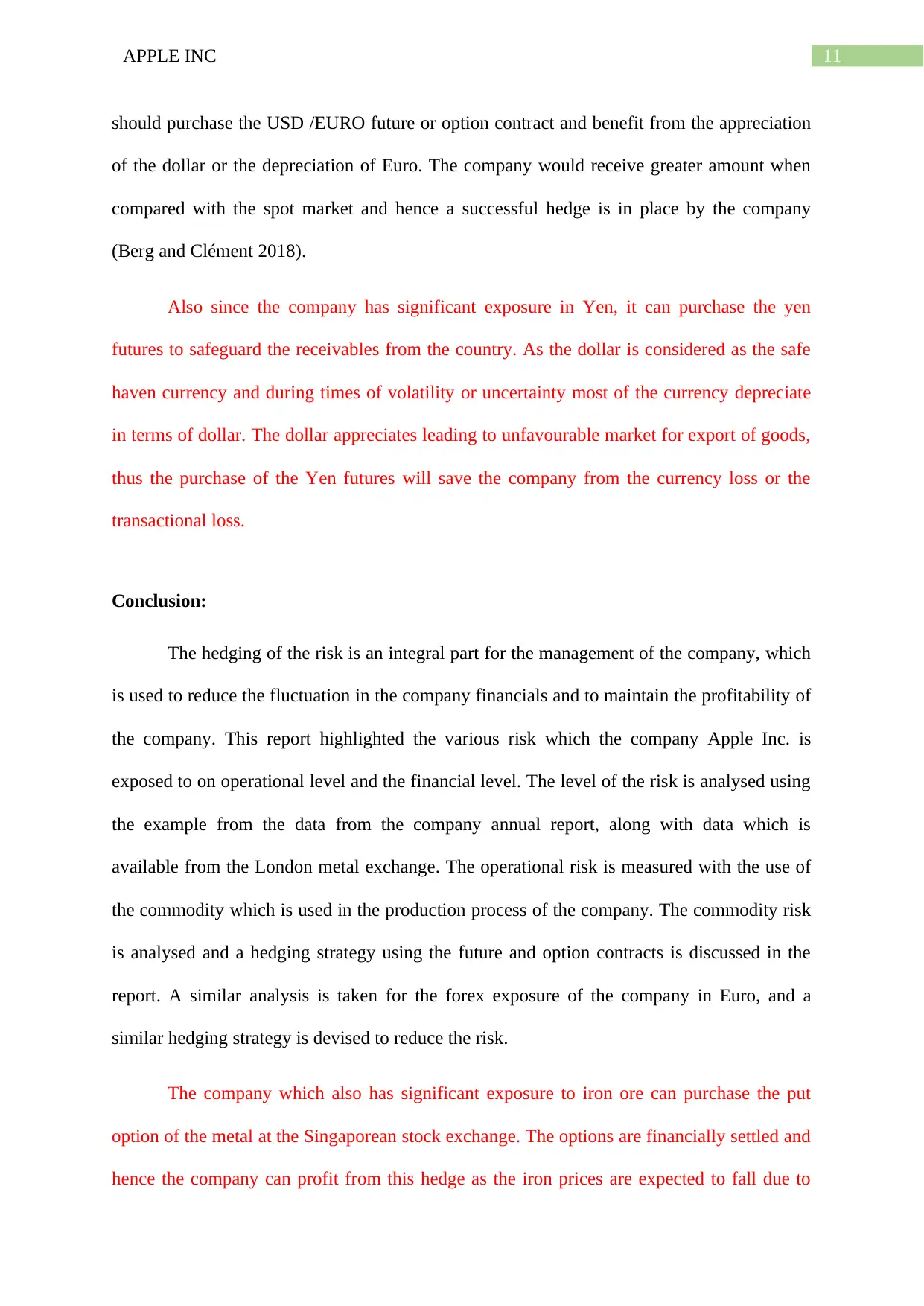
11APPLE INC
should purchase the USD /EURO future or option contract and benefit from the appreciation
of the dollar or the depreciation of Euro. The company would receive greater amount when
compared with the spot market and hence a successful hedge is in place by the company
(Berg and Clément 2018).
Also since the company has significant exposure in Yen, it can purchase the yen
futures to safeguard the receivables from the country. As the dollar is considered as the safe
haven currency and during times of volatility or uncertainty most of the currency depreciate
in terms of dollar. The dollar appreciates leading to unfavourable market for export of goods,
thus the purchase of the Yen futures will save the company from the currency loss or the
transactional loss.
Conclusion:
The hedging of the risk is an integral part for the management of the company, which
is used to reduce the fluctuation in the company financials and to maintain the profitability of
the company. This report highlighted the various risk which the company Apple Inc. is
exposed to on operational level and the financial level. The level of the risk is analysed using
the example from the data from the company annual report, along with data which is
available from the London metal exchange. The operational risk is measured with the use of
the commodity which is used in the production process of the company. The commodity risk
is analysed and a hedging strategy using the future and option contracts is discussed in the
report. A similar analysis is taken for the forex exposure of the company in Euro, and a
similar hedging strategy is devised to reduce the risk.
The company which also has significant exposure to iron ore can purchase the put
option of the metal at the Singaporean stock exchange. The options are financially settled and
hence the company can profit from this hedge as the iron prices are expected to fall due to
should purchase the USD /EURO future or option contract and benefit from the appreciation
of the dollar or the depreciation of Euro. The company would receive greater amount when
compared with the spot market and hence a successful hedge is in place by the company
(Berg and Clément 2018).
Also since the company has significant exposure in Yen, it can purchase the yen
futures to safeguard the receivables from the country. As the dollar is considered as the safe
haven currency and during times of volatility or uncertainty most of the currency depreciate
in terms of dollar. The dollar appreciates leading to unfavourable market for export of goods,
thus the purchase of the Yen futures will save the company from the currency loss or the
transactional loss.
Conclusion:
The hedging of the risk is an integral part for the management of the company, which
is used to reduce the fluctuation in the company financials and to maintain the profitability of
the company. This report highlighted the various risk which the company Apple Inc. is
exposed to on operational level and the financial level. The level of the risk is analysed using
the example from the data from the company annual report, along with data which is
available from the London metal exchange. The operational risk is measured with the use of
the commodity which is used in the production process of the company. The commodity risk
is analysed and a hedging strategy using the future and option contracts is discussed in the
report. A similar analysis is taken for the forex exposure of the company in Euro, and a
similar hedging strategy is devised to reduce the risk.
The company which also has significant exposure to iron ore can purchase the put
option of the metal at the Singaporean stock exchange. The options are financially settled and
hence the company can profit from this hedge as the iron prices are expected to fall due to
⊘ This is a preview!⊘
Do you want full access?
Subscribe today to unlock all pages.

Trusted by 1+ million students worldwide
1 out of 16
Related Documents
Your All-in-One AI-Powered Toolkit for Academic Success.
+13062052269
info@desklib.com
Available 24*7 on WhatsApp / Email
![[object Object]](/_next/static/media/star-bottom.7253800d.svg)
Unlock your academic potential
Copyright © 2020–2025 A2Z Services. All Rights Reserved. Developed and managed by ZUCOL.





